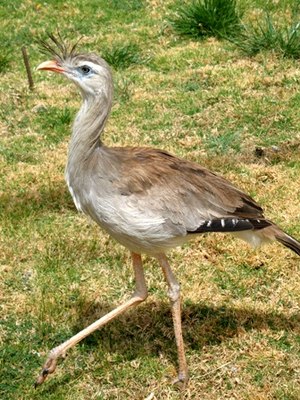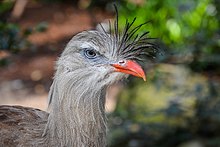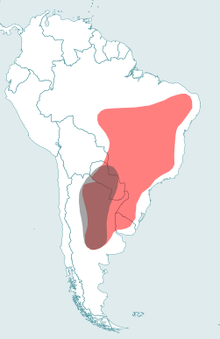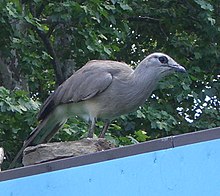Seriemas
| Seriemas | ||||||||||||
|---|---|---|---|---|---|---|---|---|---|---|---|---|

Rotfußseriema ( Cariama cristata ), young animal - still without the orange-red color of the beak and legs |
||||||||||||
| Systematics | ||||||||||||
|
||||||||||||
| Scientific name | ||||||||||||
| Cariamidae | ||||||||||||
| Bonaparte , 1853 |
The Seriemas (Cariamidae) are a family of predominantly ground-dwelling birds that are common in dry, open landscapes of central and eastern South America . They are divided into two genera , each with one species . The long-legged, ground-dwelling Seriemas are believed to be related to the extinct terror birds . Both species are listed as not endangered by the IUCN .
features
anatomy
Seriemas are after the rheas , with which they share some morphological and behavioral characteristics, the largest predominantly ground-living birds in South America. Both types, the Rotfußseriema and the Schwarzfußseriema or Tschunja, show a similar physique. With an average weight of 1.5 kg and a body length of up to 90 cm, the Rotfußseriema is slightly larger and heavier than the Schwarzfußseriema, which has a body length of 70 to 85 cm and a weight of 1.2 kg. The legs, which are bright red or black, depending on the species, are long and slender, three strong toes point forward, the rear toe is smaller and set a little higher ( anisodactyly ). The neck is long but still strong, the large head appears wedge-shaped. Another characteristic is the strong beak that reaches a third of the length of the head . The upper bill is strongly curved and longer than the lower bill, it ends in a pointed, downwardly directed hook. Seriemas fly seldom and badly; the wings are short and rounded.
Coloration and plumage
The plumage of the Seriemas has some special features. Especially in the head and neck area, as well as on the chest and stomach, it consists of narrow feathers that lie loosely on the body. Both types can set up these feathers in the neck to form a hood . In the case of the Rotfußseriema, some stiff feathers at the base of the beak also form a permanently upright tuft of feathers, which can be up to 10 cm in length and is often slightly bent forward.
The plumage of the Seriemas is gray-brown, with the breast and abdominal plumage being lighter gray than the head, coat and back. A narrow, light stripe runs just above the eye. Towards the rump the abdominal plumage becomes lighter and finally cream-colored. The long tail feathers are the darkest part of the visible plumage and can appear almost black in individual individuals; Only at the end of the Rotfußseriema do they have narrow white markings, which, however, are not always visible. As with the hand and arm wings , which are just as dark and have white stripes, this coloration can only be recognized when the birds are flying or spreading their wings; the drawing is hidden in standing and running birds. A fine, dark transverse grain of the plumage occurs all over the body, but is not particularly noticeable and can only be seen from a short distance. Sex dimorphism does not occur in Seriemas with regard to the plumage. Young birds are similar to adult animals, but are marked darker on the head, neck and back. In adult red-footed series, the bright red legs and the equally colored beak, the bare blue facial skin that extends from the base of the beak to around the eye and the yellow iris stand out from the gray-brown plumage. The Schwarzfußseriema does not show such colors, its legs are colored black or dark gray, it does not show any bare eye ring and the color of the iris is maroon.
Move
Seriemas are ground-dwelling birds that slowly walk around on their long legs. The body is held slightly upright and the gait appears to strut. Food is either ingested immediately with a quick push of the head or pursued over short distances in a quick run, held and broken down with the beak. Occasionally, seriemas sit on the intertarsal joints in order to be able to take up small food from the floor more easily or to rest. If they are disturbed or feel threatened, they can run at speeds of up to 70 km / h. When running, Seriemas look as if they are gliding across the terrain, the body is kept relatively motionless over the legs. Seriemas very rarely fly up, for example when they are frightened or want to find a nesting or sleeping place in a tree. In these cases they flap open a little awkwardly, flap their wings a few times and glide the rest of the short flight. Whenever possible, the birds climb trees by holding onto the trunk and branches with their strong claws and hopping around in the branches, keeping their wings balanced.
voice
In their area of distribution , the Seriemas are known for their penetrating, peculiar sounding vocals . It consists of a large number of shrill calls in quick succession, each of which lasts for about a second. The single call sounds like a cracking squeak and is often compared to the yapping of young dogs , but at least from a distance it does not sound unmelodious. Vocalizations can mainly be heard in the morning , less often during the day and in the evening . Reputation plays an important role in defending the vast territory . Mated birds answer each other when they hear the call of the other partner and then call in a duet. Only seldom do young birds join in with the song of their parent animals. Seriemas from neighboring territories apparently feel animated to shout by the singing of the neighboring groups and answer regularly. Often the birds sing from trees or termite mounds to make the song audible over a larger area. While calling, the animals tear their beak wide open and jerk their necks backwards with each call; with particularly loud calling animals, the head can almost touch the back. Young birds begin to imitate their parents' calls after two to three weeks. A low-frequency sound is known from young Schwarzfußseriemas, which is emitted when begging for food. Red-footed series mas can also growl when they are frightened or agitated, while a faint squeak can occasionally be heard during courtship and in the sleeping area.
distribution and habitat
The largely open and dry areas of South America east of the Andes and south of the Amazon basin are the range of the Seriemas. For example, they are represented in the Pampas and Gran Chaco . The largest population of the Rotfußseriema can be found in the semi-arid cerrados , the grass savannahs in the highlands of Brazil . Further south, subtropical areas of Brazil, Uruguay and Argentina as well as the Monte are inhabited. The Schwarzfußseriema occurs in a smaller distribution area; it prefers dry, sparsely tree-lined areas in the lowlands, such as those found in Monte and Gran Chaco. In Argentina and Paraguay , both species occur sympatricly , whereby the red-footed seriema, unlike the smaller black-footed seriema, also populates higher-lying areas, sometimes it can be found above the tree line . The species apparently occupy different ecological niches , in addition, the red-footed series move to cooler areas during the warm half of the year, while the black-footed series move away during the cooler times and are more represented in summer. As a cultural successor , the Rotfußseriema also occurs on human-made agricultural areas that were previously forested. Therefore, the species can currently expand its range. The Schwarzfußseriema also seems to increase its range, albeit to a much lesser extent. In 1981 a bird of this species was recorded in Bolivia for the first time .
Way of life
Territory and migration behavior
Especially during the breeding season, Seriemas defend a territory that is dependent on the size of existing nesting sites and food, but always several hectares in size, which is defended by the partners calling out. If there are direct conflicts at the borders of a territory, the birds threaten first, if they fail they fight with flapping their wings and kicks until the losing couple takes flight. Outside the breeding season, the territory is less intensively defended, but still exists.
As sedentary and territorial animals, Seriemas are not migratory birds in large parts of their range , but subpopulations of both species in the Gran Chaco move short distances to warmer or cooler areas during the cold or warm season. The Rotfußseriema must also be able to cover longer distances, as it will settle in isolated steppe areas that are emerging there in the course of clearing the Amazon basin. It is also represented on the isolated high plateau of the Itatiaia Mountains in south-east Brazil. Another explanation for this occurrence is that it is a relic population from the Pleistocene , since during this time the grasslands of central South America covered larger areas than they do today.
Activity and comfort behavior
As diurnal birds, Seriemas go to a tree at dusk, the branches of which serve as a place to sleep. If possible, the sleeping area is reached by climbing. Seriemas spend the night sleeping close to each other. The head is not hidden under a wing while sleeping, but held in front of the body with the neck drawn in. During the day, the birds occasionally lie on their stomachs with their legs bent under their bodies; their wings are spread apart for sunbathing. Less often the bird lies on its side and stretches one wing in the air to sunbathe. Fluffing of the plumage with simultaneous retraction of the neck was observed as comfort behavior .
Social and antagonistic behavior
Most seriemas roam their territory in pairs, during and after the breeding season the young birds join their parents. At night, partners and any young birds that may be present often sleep close together. The animals always keep eye contact with one another while foraging and warn one another of possible dangers.
Even in the event of minor disturbances, the members of a group warn each other with a growling or hissing startling noise, and the whole group often runs away immediately afterwards. All animals follow the group member who fled first, regardless of whether they themselves have perceived the danger or not. It is less common for birds to press flat on the ground behind trees or stones or fly up to avoid danger. If a Seriema sees no possibility of escape, it shows an impressive behavior by spreading the black and white drawn wings, erecting the upper body steeply, raising the neck feathers to the hood and puffing up the remaining plumage in order to impress and frighten the opponent.
nutrition
The diet of the Seriemas consists predominantly of animal food, especially insects such as grasshoppers and beetles . Seriemas often stay near larger animals such as horses and cattle in order to catch small animals that are startled by them. Frogs , lizards , snakes , chicks and small rodents are also caught and eaten on occasion . Areas that had recently burned down due to steppe fires, which occurred very frequently in summer, are sought out by the birds in order to look for injured or uncovered small animals. Plant-based food is also consumed to a much lesser extent, mainly consisting of fruits and seeds. While searching for food, the birds strut slowly around and observe the ground and the low vegetation in order to discover hidden animals. If a prey is discovered, the Seriemas pause for a moment and then slowly move towards it until they can grab the animal by jerking their neck with their beak. Smaller food up to the size of small lizards is twisted in the beak and swallowed head first in one piece, larger animals such as snakes or rodents are held with the sharply clawed feet and cut into smaller pieces with the beak. Before this, larger prey is killed by blows with the beak. Sometimes prey animals are taken in the beak and beaten against stones or other hard objects until they are dead after several attempts. Eggs and snails are handled in a similar way to open them. In order to pick up larger quantities of seeds from the ground, Seriemas sit on the tarsal joints in order to reach the ground more easily.
Reproduction
There is only sparse information on the breeding behavior of wild seriemas, and most of the knowledge, which is poor despite everything, was obtained from captive birds. Almost nothing is known about the breeding behavior of the black-footed series, which have only been sparsely researched in all respects. Because of their otherwise great similarity to the Rotfußseriema, it is assumed that their breeding behavior is similar to that of this species.
Pair formation
Depending on the area, the beginning of the breeding season probably varies depending on the climatic conditions. Most of the nests seem to be created in the rainy season , which in central Brazil corresponds to the period between September and May. The monogamous Seriemas defend a breeding territory and do not tolerate any further couples in their vicinity. Before mating, the male mates on the female by spreading his black and white drawn wings and fanning out the black and white tail feathers. Then the partners perform a kind of mating dance in which the male struts upright, strutting next to the female with a slightly raised bonnet and lays his head against the neck, holding his beak perpendicular to the ground.
Nest building and nest location
Nests are created exclusively in larger, stable trees and are usually between one and five meters high, but can also be created in the crown at a height of up to nine meters. If possible, the breeding pair chooses a place in the branches to build a nest that they can reach by climbing and jumping. The very voluminous nest is created jointly by the breeding pair and consists of untidily stuck together branches, the nesting trough is lined with small twigs, grass, sometimes with dung and clay. It takes an average of 30 days for the nest to be built.
Clutch and brood
Usually two, less often three eggs are laid in the finished nest . These have dimensions of 57–72 × 46–50 mm for the Rotfuß and 56–61 × 42–46 mm for the Schwarzfußseriema. Originally colored white and flecked with light brown, the eggs are colored completely brown after a short time by the clay in the nest. The incubation is mainly carried out by the female and takes between 24 and 30 days.
Chicks of the Seriemas are nestled and initially feathered with thin, brown downs that are particularly long on the head and neck and look like hair. After hatching, they weigh about 40 grams. Both parent animals feed the offspring, which leave the nest at around fourteen days old. After this time, the young birds jump from the nest directly onto the ground and follow their parents waiting there. At around one month old, the offspring are fully fledged, while the weight and appearance of adult birds are only achieved after around 5 months. The age at which Seriemas are able to reproduce is not known.
Tribal history
The oldest species belonging to the suborder Cariamae, which is now extinct until the Seriemas (Cariamidae), are known from the Paleocene and were found in Brazil. Further fossils of related families have been discovered in the Oligocene layers of North and South America , as well as in the Eocene layers of the Messel Pit ( Salmila robusta ). The extinct terror birds are regarded as relatives of today's Seriemas and together with them are placed in the order Cariamiformes .
Systematics
The Seriemas were placed in the order of the crane birds (Gruiformes) until recently , but this has long been controversial because of their different anatomy . Benirschke was of the opinion that the Seriemas were more closely related to the secretary . Sibley and Ahlquist put the Seriemas in 1990 due to the existing differences to other members of the crane birds in the suborder Cariamae, which should represent a sister taxon of the suborder Grues ( claws , cranes , cranks , trumpet birds ). The Seriemas (Cariamidae) therefore formed the only family within the Cariamae. According to phylogenetic studies by Cracraft and Barker, the closest relatives of the Seriemas living today are the bustards and the kagu . According to a new phylogenetic molecular genetic study, the Seriemas are not closely related to the crane birds, but are sister taxons of a larger group of birds, which includes the Falconidae , parrots and songbirds . On the basis of this study, they are regarded by the South American Classification Committee, a committee of the American Ornithologists' Union and the International Ornithological Congress as the monotypical order Cariamiformes and are thus also listed in the World Bird List.
Rotfußseriema and Schwarzfußseriema are closely related species that are placed in the monotypical genera Cariama and Chunga , respectively. Whether this classification is justified or whether both species should be assigned to a common genus is controversial.
- Genus Cariama :
- Rotfußseriema , Cariama cristata
- Genus Chunga :
- Schwarzfußseriema or Tschunja, Chunga burmeisteri
Seriemas and human

In their area of distribution, the Seriemas are known primarily because of their penetrating reputation and unusual appearance. Already Prince Maximilian of Wied-Neuwied , who traveled in the 19th century as one of the first European naturalists South America, mentioned widely audible to several kilometers reputation of Seriemas. The name of the genus Cariama is derived directly from the Tupí word "Çariama", which means who wears an upright hood . "Seriema" is also derived from "Çariama", but under the influence of the word Ema , the name for the rhea in Brazil. The name alludes to the partly similar way of life of the Seriemas and Nandus.
The Seriemas are particularly popular with the rural population of Brazil and Argentina, as they are said to eat large quantities of poisonous snakes and other unpopular animals. In parts of Brazil the belief is widespread that there are no more snakes to be found in areas with occurrences of Seriemas. It is also believed there that the Seriemas are immune to snake venom .
Seriemas have been popular pets in bird parks and zoos since the 19th century . In their original area of distribution, Seriemas have enjoyed great popularity as guardians for a long time. They are caught as young animals, reared by hand and finally socialized with chickens or other poultry. When unknown people or predators approach, the Seriemas warn the chickens and their owners by shouting.
Seriemas are rarely specifically hunted , although their cooked meat, usually served with vegetables, was a widespread and very popular dish in northern Argentina at the beginning of the 20th century.
Threat and protection
Both species are classified as not endangered by the IUCN . Obviously, there is no danger in the near future that the populations of the species could collapse on a large scale. Although the Rotfußseriema in particular is a crop follower , intensified agriculture and the use of pesticides can damage local populations. However, losses can be compensated for by both species thanks to the large distribution area. Due to extensive clearing of the rainforest, the range of the Seriemas is currently expanding. However, exact inventory figures are difficult to determine and are not available.
swell
Much of the information in this article is taken from:
- Josep del Hoyo , Andrew Elliot, Jordi Sargatal: Handbook of the birds of the world. Volume 3: Hoatzin to Auks. Lynx Edicions, Barcelona 1996, ISBN 84-87334-20-2 .
The following sources are also cited:
- ^ KH Redford, G. Peters. Notes on the biology and song of the Red-legged Seriema (Cariama cristata) . In: Journal Of Field Ornithology , Vol.57, No.4, pp. 261–269 ( online ; PDF; 635 kB)
- ^ S. Hallage. North American Studbook for the Red-legged Seriema (Cariama cristata) . Smithsonian National Zoological Park 2004 ( PDF )
- ↑ DC Cole, CG Schmitt. First Records of Black-Legged Seriema (Chunga burmeisteri) in Bolivia . In: The Condor , Vol. 83, No. 2, pp. 182-183
- ↑ G. Mayr. A new specimen of Salmila robusta (Aves: Gruiformes: Salmilidae n. Fam.) From the Middle Eocene of Messel . In: Palaeontological Journal 2002, Vol. 76, No. 2, pp. 305-316 ( online )
- ↑ RJ Benirschke. Karyological difference between Sagittarius and Cariana (Aves) . In: Cellular and Molecular Life Sciences (CMLS) 1977, Vol. 33, No. 8, pp 1021-1022 ( doi: 10.1007 / BF01945944 )
- ^ CG Sibley, JE Ahlquist: Phylogeny and Classification of Birds. In: Yale University Press , New Haven, CT, 1990.
- ↑ J. Cracraft, FK Barker et al. Phylogenetic Relationships among Modern Birds (Neornithes). Assembling the Tree of Life 2004, pp. 468-489 ( online )
- ↑ SJ Hackett, RT Kimball, S. Reddy et al. A Phylogenomic Study of Birds Reveals Their Evolutionary History . In: Science 2008, Vol. 320, No. 5884, pp 1763 - 1768 doi : 10.1126 / science.1157704
- ↑ Proposal (# 290) to South American Classification Committee - Recognize Cariamidae in their own Order, Cariamiformes ( Memento of the original from April 11, 2014 in the Internet Archive ) Info: The archive link was inserted automatically and has not yet been checked. Please check the original and archive link according to the instructions and then remove this notice.
- ^ IOC World Bird List - Order Cariamiformes
- ↑ Cariamidae in the IUCN Red List of Threatened Species 2007. Accessed January 15, 2008.
Web links
- Seriemas in the Internet Bird Collection
- Birdlife International factsheet, 2007
- Cariamidae on the IUCN Red List of Threatened Species .
- Pictures of the Rotfußseriema
- xeno-canto: Sound recordings - Black-legged Seriema ( Chunga burmeisteri )
- xeno-canto: Sound recordings - Red-legged Seriema ( Cariama cristata )





